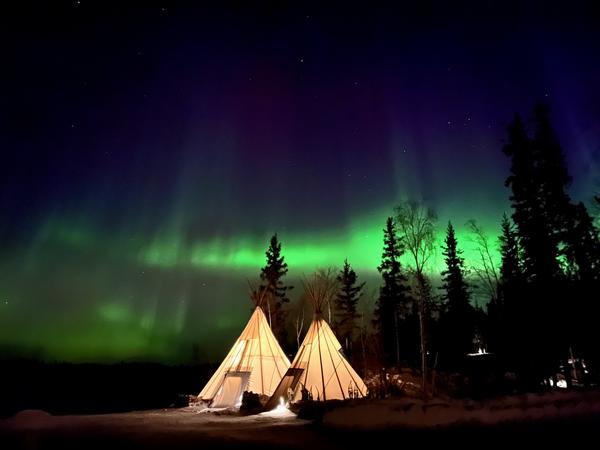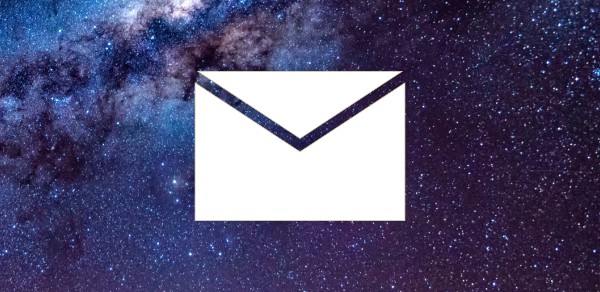This page describes an image Northern Lights - Teepees
Image caption:
Taken with a smartphone at Cassidy Point, Yellowknife, Canada, on 24 March 2023, this stunning display captured the ethereal Northern Lights painting the night sky. The biting cold of -20°F (-29°C) set the stage for the vibrant hues of the Aurora Borealis, a celestial ballet created by collisions between charged solar particles and the Earth's atmosphere. The Earth’s magnetic field directs the charged particles towards the polar regions, where they interact with the various atoms and molecules in the atmosphere. This natural phenomenon transforms the sky into a canvas of radiant greens, pinks, and purples, casting a mesmerising glow above. The different colours of an aurora are determined by the gases in Earth’s atmosphere, the altitude where the aurora occurs, the density of the atmosphere, and the energy of the charged particles. In general, green is attributed to oxygen molecules, red is associated with high-altitude oxygen molecules, purple and blue are associated with hydrogen and helium, and pink aurorae are typically associated with nitrogen. Against this cosmic backdrop, the teepees of Aurora Village below provide a tranquil contrast to the celestial spectacle unfolding overhead. Preserving the pristine darkness of this location ensures the continued splendour of such awe-inspiring natural light shows.
Scroll to captions in other languages
Image credit:
Oanh Vuong/IAU OAE (CC BY 4.0)
DOI: 10.5281/zenodo.10359618
Tags:
astrophotography
Related glossary terms:
Aurora
, Aurora Borealis
, Geomagnetic Storm
Categories:
Naked Eye Astronomy
, Planet Earth
Image license: Creative Commons Attribution 4.0 International (CC BY 4.0) Creative Commons Attribution 4.0 International (CC BY 4.0) icons
The media file captions presented on the OAE website were written, translated and reviewed by a collective effort from the OAE, the OAE Centers and Nodes, the OAE National Astronomy Education Coordinators (NAECs) and other volunteers. You can find a full list of credits for our translation project here. All media file captions are released under a Creative Commons CC BY-4.0 license and should be credited to "IAU OAE". The media files themselves may have different licenses (see above) and should be credited as listed above under "credit".
Captions in Different Languages:
Image caption: Mention honorable au concours d'astrophotographie 2023 de l'UAI OAE, catégorie Images fixes avec smartphones-appareils mobiles : Aurores boréales - Teepees, par Oanh Vuong.
Prise à Cassidy Point, Yellowknife, Canada, le 24 mars 2023, cette image étonnante montre des aurores boréales qui illuminent le ciel nocturne. Elle reçoit une mention honorable dans la catégorie des images fixes prises exclusivement avec des smartphones/appareils mobiles. Un froid mordant (-29 °C) est propice à l'observation des aurores boréales, ballet céleste créé par les collisions entre les particules solaires chargées et l'atmosphère de la Terre. Le champ magnétique terrestre dirige les particules chargées vers les régions polaires, où elles interagissent avec les différents atomes et molécules de l'atmosphère. Ce phénomène naturel transforme le ciel en une toile de verts, de roses et de violets radieux, projetant une lueur envoûtante. Les différentes couleurs d'une aurore sont déterminées par les gaz présents dans l'atmosphère terrestre, l'altitude à laquelle l'aurore se produit, la densité de l'atmosphère et l'énergie des particules chargées. En général, le vert est attribué aux molécules d'oxygène, le rouge est associé aux molécules d'oxygène de haute altitude, le violet et le bleu sont associés à l'hydrogène et à l'hélium, et les aurores roses sont typiquement associées à l'azote. Sur ce fond cosmique, les tipis du village d'Aurora, en contrebas, offrent un contraste avec le spectacle céleste qui se déroule au-dessus de nos têtes. La préservation de l'obscurité en cet endroit permet d'accéder à la splendeur de ces impressionnants spectacles de lumière naturelle.
Image credit: Oanh Vuong/UAI OAE (CC BY 4.0)
Related glossary terms: Aurore , Aurore boréale , Tempête géomagnétique Caption translation status: Not yet approved by a reviewer
Caption translators: Rulx Narcisse, Gilles Remy
Image caption: Menzione d'onore al concorso di astrofotografia IAU OAE 2023, categoria Immagini fisse con smartphone-dispositivi mobili: Northern Lights - Teepees, di Oanh Vuong.
Scattata a Cassidy Point, Yellowknife, Canada, il 24 marzo 2023, questa splendida immagine ha catturato l'eterea aurora boreale che dipinge il cielo notturno. Riceve una menzione d'onore nella categoria Immagini fisse scattate esclusivamente con smartphone/dispositivi mobili. Il freddo pungente di -29°C ha fatto da sfondo alle vibranti tonalità dell'Aurora Boreale, un balletto celeste creato dalla collisione tra particelle solari cariche e l'atmosfera terrestre. Il campo magnetico terrestre dirige le particelle cariche verso le regioni polari, dove interagiscono con i vari atomi e molecole dell'atmosfera. Questo fenomeno naturale trasforma il cielo in una tela di verdi, rosa e viola radiosi, proiettando un bagliore ipnotico. I diversi colori di un'aurora sono determinati dai gas presenti nell'atmosfera terrestre, dall'altitudine in cui si verifica l'aurora, dalla densità dell'atmosfera e dall'energia delle particelle cariche. In generale, il verde è attribuito alle molecole di ossigeno, il rosso è associato alle molecole di ossigeno ad alta quota, il viola e il blu sono associati all'idrogeno e all'elio, mentre le aurore rosa sono tipicamente associate all'azoto. Su questo sfondo cosmico, i teepee dell'Aurora Village offrono un tranquillo contrasto con lo spettacolo celeste che si svolge sopra di noi. La conservazione dell'oscurità incontaminata di questo luogo garantisce il continuo splendore di questi spettacoli di luce naturale.
Image credit: Oanh Vuong/IAU OAE (CC BY 4.0)
Related glossary terms: Aurora , Aurora Boreale , Tempesta Geomagnetica Caption translation status: Not yet approved by a reviewer
Caption translators: Valentina La Parola









